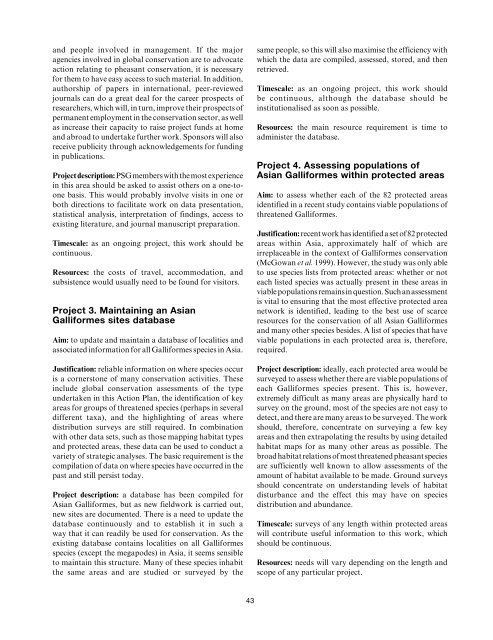Pheasants: Status Survey and Conservation Action Plan ... - IUCN
Pheasants: Status Survey and Conservation Action Plan ... - IUCN
Pheasants: Status Survey and Conservation Action Plan ... - IUCN
Create successful ePaper yourself
Turn your PDF publications into a flip-book with our unique Google optimized e-Paper software.
<strong>and</strong> people involved in management. If the major<br />
agencies involved in global conservation are to advocate<br />
action relating to pheasant conservation, it is necessary<br />
for them to have easy access to such material. In addition,<br />
authorship of papers in international, peer-reviewed<br />
journals can do a great deal for the career prospects of<br />
researchers, which will, in turn, improve their prospects of<br />
permanent employment in the conservation sector, as well<br />
as increase their capacity to raise project funds at home<br />
<strong>and</strong> abroad to undertake further work. Sponsors will also<br />
receive publicity through acknowledgements for funding<br />
in publications.<br />
Project description: PSG members with the most experience<br />
in this area should be asked to assist others on a one-toone<br />
basis. This would probably involve visits in one or<br />
both directions to facilitate work on data presentation,<br />
statistical analysis, interpretation of findings, access to<br />
existing literature, <strong>and</strong> journal manuscript preparation.<br />
Timescale: as an ongoing project, this work should be<br />
continuous.<br />
Resources: the costs of travel, accommodation, <strong>and</strong><br />
subsistence would usually need to be found for visitors.<br />
Project 3. Maintaining an Asian<br />
Galliformes sites database<br />
Aim: to update <strong>and</strong> maintain a database of localities <strong>and</strong><br />
associated information for all Galliformes species in Asia.<br />
Justification: reliable information on where species occur<br />
is a cornerstone of many conservation activities. These<br />
include global conservation assessments of the type<br />
undertaken in this <strong>Action</strong> <strong>Plan</strong>, the identification of key<br />
areas for groups of threatened species (perhaps in several<br />
different taxa), <strong>and</strong> the highlighting of areas where<br />
distribution surveys are still required. In combination<br />
with other data sets, such as those mapping habitat types<br />
<strong>and</strong> protected areas, these data can be used to conduct a<br />
variety of strategic analyses. The basic requirement is the<br />
compilation of data on where species have occurred in the<br />
past <strong>and</strong> still persist today.<br />
Project description: a database has been compiled for<br />
Asian Galliformes, but as new fieldwork is carried out,<br />
new sites are documented. There is a need to update the<br />
database continuously <strong>and</strong> to establish it in such a<br />
way that it can readily be used for conservation. As the<br />
existing database contains localities on all Galliformes<br />
species (except the megapodes) in Asia, it seems sensible<br />
to maintain this structure. Many of these species inhabit<br />
the same areas <strong>and</strong> are studied or surveyed by the<br />
same people, so this will also maximise the efficiency with<br />
which the data are compiled, assessed, stored, <strong>and</strong> then<br />
retrieved.<br />
Timescale: as an ongoing project, this work should<br />
be continuous, although the database should be<br />
institutionalised as soon as possible.<br />
Resources: the main resource requirement is time to<br />
administer the database.<br />
Project 4. Assessing populations of<br />
Asian Galliformes within protected areas<br />
Aim: to assess whether each of the 82 protected areas<br />
identified in a recent study contains viable populations of<br />
threatened Galliformes.<br />
Justification: recent work has identified a set of 82 protected<br />
areas within Asia, approximately half of which are<br />
irreplaceable in the context of Galliformes conservation<br />
(McGowan et al. 1999). However, the study was only able<br />
to use species lists from protected areas: whether or not<br />
each listed species was actually present in these areas in<br />
viable populations remains in question. Such an assessment<br />
is vital to ensuring that the most effective protected area<br />
network is identified, leading to the best use of scarce<br />
resources for the conservation of all Asian Galliformes<br />
<strong>and</strong> many other species besides. A list of species that have<br />
viable populations in each protected area is, therefore,<br />
required.<br />
Project description: ideally, each protected area would be<br />
surveyed to assess whether there are viable populations of<br />
each Galliformes species present. This is, however,<br />
extremely difficult as many areas are physically hard to<br />
survey on the ground, most of the species are not easy to<br />
detect, <strong>and</strong> there are many areas to be surveyed. The work<br />
should, therefore, concentrate on surveying a few key<br />
areas <strong>and</strong> then extrapolating the results by using detailed<br />
habitat maps for as many other areas as possible. The<br />
broad habitat relations of most threatened pheasant species<br />
are sufficiently well known to allow assessments of the<br />
amount of habitat available to be made. Ground surveys<br />
should concentrate on underst<strong>and</strong>ing levels of habitat<br />
disturbance <strong>and</strong> the effect this may have on species<br />
distribution <strong>and</strong> abundance.<br />
Timescale: surveys of any length within protected areas<br />
will contribute useful information to this work, which<br />
should be continuous.<br />
Resources: needs will vary depending on the length <strong>and</strong><br />
scope of any particular project.<br />
43
















